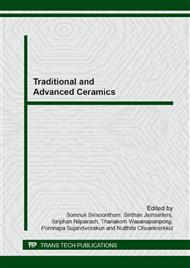p.8
p.14
p.21
p.26
p.31
p.37
p.41
p.47
p.62
Improvement of Mechanical Properties of Lightweight Ceramics with the Addition of Alumina Fiber
Abstract:
Lightweight ceramics have a low density, which leads to a decrease in strength and toughness. In the development of lightweight ceramics, high-strengthening technology is necessary. Alumina fiber was mixed with raw materials for the purpose of producing high-strength lightweight ceramics. After adding alumina fiber at 1, 3, and 5wt% and sintering at 1300°C, we found that strength and toughness increased in proportion to the amount. Instead of the high melting temperature of alumina fiber, it is reacted with matrix and generated mullite phase. And lots of alumina fiber remains in the matrix, thereby allowing improvements in strength and toughness. When alumina fiber was not added, we found a low density of 1.35~1.80 g/m3, along with low values for strength and toughness at 30~60MPa and 0.7~1.2 MPa m1/2 respectively. With 1wt% addition of alumina fiber, we obtained a higher strength of 92MPa at 1300°C, which is close to the strength of general white porcelains at 112MPa.
Info:
Periodical:
Pages:
31-36
Citation:
Online since:
April 2014
Authors:
Keywords:
Price:
Сopyright:
© 2014 Trans Tech Publications Ltd. All Rights Reserved
Share:
Citation:


